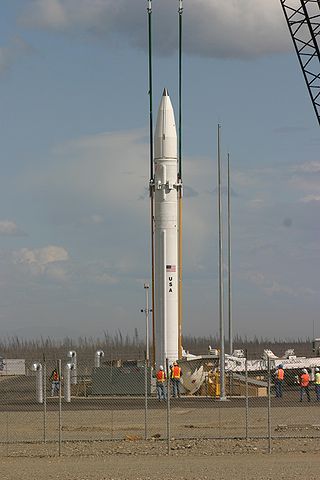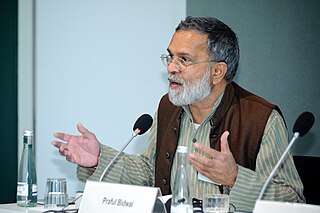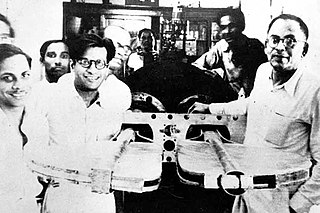Project Valiant was one of two early liquid-fueled missile projects developed by India, along with Project Devil in the 1970s. The goal of Project Valiant was to produce an intercontinental ballistic missile. Although discontinued in 1974 without achieving success, Project Valiant, like Project Devil, led to the later development of the Prithvi missile in the 1980s.
Both projects were overseen by the Defense Research & Development Laboratory (DRDL) of India, which had begun in 1958 with a specialization in anti-tank missiles but expanded in subsequent years. [1] Project Valiant was intended to be an intercontinental ballistic missile utilizing 30-ton engines to achieve a range variously reported as 1,500 kilometres (930 mi) and 8,000 kilometres (5,000 mi). [2] [3] [4] The secret project was initially funded with a few hundred thousand rupees after the presentation of a feasibility report in April 1971, but in June 1972, DRDL received 160 million rupees to fund both projects. The money came with a veil of secrecy; the Union Cabinet had publicly declined the funding request, but Prime Minister Indira Gandhi had granted it secretly through her discretionary powers. [5] In turn, DRDL took pains to disguise the purpose of the funds so that their real work would not be immediately apparent. That year, the DRDL began to expand rapidly, increasing its workforce from 400 to 2,500 people over a two-year period in an effort to meet staffing needs of both the Valiant and Devil projects. [5]
The Valiant missile was anticipated to weigh 85 tons and to use three liquid fuel stages. [4] In 1972, the lab began to work on designing and developing various components for the Valiant, [5] and the project reached the phase of ground testing on 10 May 1974. [4] However, internal disputes disrupted the DRDL, as the leader of the Valiant project believed the DRDL's director was disproportionately invested in Project Devil, and external interest in both programs waned. [5] That same year, the Union Cabinet asked the director of the DRDL to evaluate whether civilian uses could be found at the Indian Space Research Organization (ISRO) for Valiant's liquid-fuel engine. [5] The ISRO declined, and since the Valiant project was not progressing satisfactorily and it was not well-managed, the project was terminated. [4] [5]
According to a 2006 article by Praful Bidwai in The Daily Star , Project Valiant "totally failed", while its sister project was a partial success. [6] Though neither reached fruition, the projects were important precursors to the Prithvi missile developed in the 1980s. [7]

An anti-ballistic missile (ABM) is a surface-to-air missile designed to counter ballistic missiles. Ballistic missiles are used to deliver nuclear, chemical, biological, or conventional warheads in a ballistic flight trajectory. The term "anti-ballistic missile" is a generic term for a system designed to intercept and destroy any type of ballistic threat; however, it is commonly used for systems specifically designed to counter intercontinental ballistic missiles (ICBMs).

An intercontinental ballistic missile (ICBM) is a ballistic missile with a range greater than 5,500 kilometres (3,400 mi), primarily designed for nuclear weapons delivery. Conventional, chemical, and biological weapons can also be delivered with varying effectiveness, but have never been deployed on ICBMs. Most modern designs support multiple independently targetable reentry vehicle (MIRVs), allowing a single missile to carry several warheads, each of which can strike a different target. The United States, Russia, China, France, India, the United Kingdom, Israel, and North Korea are the only countries known to have operational ICBMs.

A ballistic missile (BM) is a type of missile that uses projectile motion to deliver warheads on a target. These weapons are powered only during relatively brief periods—most of the flight is unpowered. Short-range ballistic missiles (SRBM) typically stay within the Earth's atmosphere, while most larger missiles are exo-atmospheric. The largest ICBMs are capable of full orbital flight. These weapons are in a distinct category from cruise missiles, which are aerodynamically guided in powered flight and thus restricted to the atmosphere.

The Dongfeng series, typically abbreviated as "DF missiles", are a family of short, medium, intermediate-range and intercontinental ballistic missiles operated by the Chinese People's Liberation Army Rocket Force.

Prithvi is a tactical surface-to-surface short-range ballistic missile (SRBM) developed by Defence Research and Development Organisation (DRDO) of India under the Integrated Guided Missile Development Program (IGMDP). It is deployed by India's Strategic Forces Command.

The Integrated Guided Missile Development Programme (IGMDP) was an Indian Ministry of Defence programme for the research and development of the comprehensive range of missiles. The programme was managed by the Defence Research and Development Organisation (DRDO) and Ordnance Factories Board in partnership with other Indian government political organisations. The project started in 1982–83 under the leadership of Abdul Kalam who oversaw its ending in 2008 after these strategic missiles were successfully developed.
The Dong Feng 4 or DF-4 is a first-generation two-stage Chinese intercontinental ballistic missile with liquid fuel. It was thought to be deployed in limited numbers in underground silos beginning in the late 1970s and early 1980s. The Dong Feng 4 has a takeoff thrust of 1,224.00 kN, a takeoff weight of 82000 kg, a diameter of 2.25 m, a length of 28.05 m and a fin span of 2.74 m. The range of the Dong Feng 4, which is equipped with a 2,190 kg nuclear warhead with 3.3 Megaton yield, with a nominal range of 5,500 km. This gives it sufficient range to strike targets as far away as Russia, India, and American bases in the Pacific. The missile uses an inertial guidance system, resulting in a large CEP of 1,500 meters. As of 2017, 10–15 launchers are deployed.

Praful Bidwai was an Indian journalist, political analyst, and activist. He was known for his left-leaning analysis of India's politics and economics. In Bidwai's memory, his friends, including the Transnational Institute, created the Praful Bidwai Memorial Award intended to honor and highlight courageous and independent voices in journalism.

The RSM-56 Bulava is a submarine-launched ballistic missile (SLBM) developed for the Russian Navy and deployed in 2019 on the new Borei class of ballistic missile nuclear submarines. It is intended to serve as a crucial component of Russia's nuclear triad. The weapon takes its name from bulava, a Russian word for mace.
The Indian Ballistic Missile Defence Programme is an initiative to develop and deploy a multi-layered ballistic missile defence system to protect India from ballistic missile attacks. It was launched in 2000 after Kargil War by the Atal Bihari Vajpayee government. Testing was carried out and continuing as of 2006, and the system was expected to be operational four years from then according to the head of the country's missiles development programme, Vijay Kumar Saraswat.
The Surya missile ('Sun') is a speculated intercontinental ballistic missile being developed by Defence research and development organization of India. Its operational range is beyond 16,000 Km, covering the entire earth.
Project Devil was one of two early liquid-fueled missile projects developed by India, along with Project Valiant, in the 1970s. The goal of Project Devil was to produce a short-range surface-to-surface missile. Although discontinued in 1980 without achieving full success, Project Devil led to the later development of the Prithvi missile in the 1980s.

Prahaar ("Strike") is an Indian solid-fuel road-mobile tactical ballistic missile developed by the Defence Research and Development Organisation (DRDO). Prahaar is expected to replace the Prithvi-I short-range ballistic missile in Indian service.
India has studied, produced and used various strategic and tactical missile systems since its independence. Decades long projects have realised development of all types of missile systems including ballistic, cruise, anti-ship, air-defence, air-to-air and anti-missile systems. India is one of seven countries in the world with intercontinental ballistic missiles (ICBMs) and one of four countries with anti-ballistic missile systems. Since 2016, India has been a member of Missile Technology Control Regime (MTCR).

Basanti Dulal Nag Chaudhuri was an Indian Nuclear scientist and academic, and Scientific Advisor to the Ministry of Defence, Government of India. He is known as one of the pioneers of nuclear physics in India. While serving as the Director General to the Defence Research and Development Organisation (DRDO), he played influential role in Pokhran-I , India's first successful Nuclear bomb test on 18 May 1974. He also initiated the first feasibility studies on India's ballistic missile program.
The Hwasong-13, also known as Nodong-C or KN-08 under the U.S. naming convention, is a road-mobile intercontinental ballistic missile believed to be under development by North Korea. The changes shown in the mock-up displayed in October 2015 indicated a change from a three- to two-stage design.
The RS-28 Sarmat, often colloquially referred to as Satan II by media outlets, is a three-stage Russian silo-based, liquid-fueled, HGV-capable and FOBS-capable super-heavy intercontinental ballistic missile (ICBM) produced by the Makeyev Rocket Design Bureau. It is intended to replace the Soviet R-36M ICBM in Russia's arsenal.

The 9M730 Burevestnik is a Russian low-flying, nuclear-powered, nuclear-armed cruise missile under development for the Russian Armed Forces. According to the Russian Ministry of Defense, the missile's range is effectively unlimited.
K-6 is an intercontinental submarine-launched ballistic missile under development by Defence Research and Development Organisation of India. The missile has a planned range of around 10,000 to 12,000 kilometres.